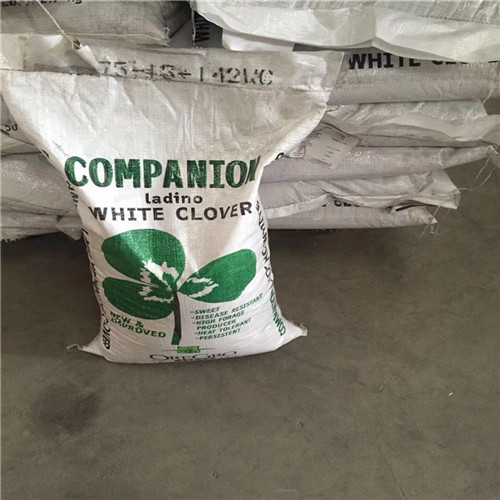
White clover is rich in nutrients and nutrient elements. It has rich nutrition, greening, genetic breeding and medicinal value species. It can be used as green manure, bank protection grass species, smile decoration, as well as nectar and medicinal materials.
(1)forage grass for animal
White clover has excellent palatability and high digestibility. It is a favorite food for all kinds of livestock and poultry. It is suitable for breeding cattle, sheep, and herbivorous fish. Nutrient composition and digestibility are higher than alfalfa and red clover. On natural grasslands, the forage value of grass groups also increases with the increase in the proportion of white clover, and the yield of hay and seed yield varies from region to region. It has the characteristics of early germination, late decline, and long forage season. In the south The grass supply season is from April to November. White clover has a creeping stem, a long petiole and a low grass layer. Therefore, it eats more leaves and tender stems when grazing.
At the same time, as the age of the grass grows, its digestibility decreases slower than other pastures. White clover has the characteristics of resistance to trampling, rapid expansion, backward formation of herds and strong weed competitiveness, so it is mostly used for grazing. However, moderate grazing is required to facilitate the re-growth of white clover. When feeding, it should be fed with gramineous forages to achieve carbon and nitrogen balance and prevent bloat disease from single-feeding white clover. In addition, sun-dried grass powder can be used as a raw material for compound feed.
(2)For Lawn grass
White clover has beautiful leaf color and flower color, a long green period, and low planting and maintenance costs. It only takes 30-40 days from sowing to planting. Once planted, it can be used continuously for 6-7 years or even 10 years. With strong self-sown reproduction ability, it is an excellent green ornamental lawn species, which can be planted in a patch or mixed with trees and shrubs to form a layered compound landscape. Mixed cultivation with other warm-season lawns can extend the green period. White clover has a well-developed root system and dense lateral roots, which can fix the soil. The dense leaves can block the erosion and wind erosion of the soil by rainwater. Therefore, the effect of water storage and soil conservation is obvious. Create a gorgeous natural ecological landscape. It is not prone to pests and diseases, and there are few weeds. There is basically no need to manually remove impurity after it is formed, which effectively reduces the amount of weeding labor and the use of chemical herbicides.
(3)Medicinal value
The whole herb of Trifolium repens is a human medicine, slightly sweet in taste, mild in nature, and has the effects of clearing away heat and cooling blood, soothing the nerves, analgesic, expectorating and relieving cough. Foreign clinical trials have reported that the tincture of white clover flower can be used to treat colds, and the whole herb tincture has astringent and hemostatic effects, and is used as a medicine to stop bleeding and promote wound healing. It has also been found that the isoflavones contained therein have anti-cancer effects. The macromolecular polysaccharide extracted from white clover has a series of medicinal and health care functions such as improving immunity, anti-tumor, anti-aging, and lowering blood lipids.
 Pingnan Junong Mountain Farming Specialized Farmers Cooperative
Pingnan Junong Mountain Farming Specialized Farmers Cooperative